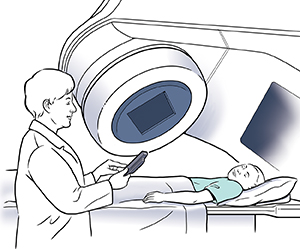Treating Cancer in Children: Radiation Therapy
Radiation therapy helps your child fight cancer. It uses strong X-rays to kill cancer cells. But the treatment can also cause side effects. Read on to learn about radiation and how you can help your child cope with its side effects.
 |
| With external radiation, a machine sends high-energy x-rays to the area where a tumor is located. |
How radiation therapy works
The goal of radiation therapy is to direct the X-ray beams on cancer cells. Radiation kills these cancer cells slowly, over time. After radiation therapy ends, cancer cells keep dying for weeks or months. But this treatment can also damage or kill the normal, healthy cells near the tumor. These damaged normal cells often can fix themselves.
Types of radiation
Different types of radiation can be used to treat childhood cancers:
-
External radiation. A machine sends high-energy X-rays from outside the body to where a tumor is located. The machine moves around the body. It does not touch your child. This allows the X-ray beams to enter the body at certain angles. There are different ways to deliver external beam radiation. Talk to your healthcare team about which way is best for your child.
-
Intraoperative radiation therapy. This type of treatment is done during surgery. First, as much of the tumor as possible is removed. Then nearby organs are moved out of the way while a machine sends beams of high-energy X-rays directly to a tumor site. This type of radiation therapy is less commonly used for children. Your healthcare team can tell you more if needed.
-
Brachytherapy. This is a form of internal radiation. Radioactive material is placed inside the body on or near the tumor.
What to expect
Treatment depends on the type of cancer your child has and what their healthcare team decides is best for your child. External radiation is most often used for children. It is usually given on an outpatient basis. This means the child goes to the hospital or treatment center to receive treatment and then goes home. The child does not stay overnight. The child may need to visit the hospital or center for radiation therapy 5 days a week for several weeks:
-
Before treatment, a practice run takes place. You may hear this called a simulation. During this session, your child lies on an X-ray table. The exact areas of the body where the radiation beams will be sent are chosen and marked on your child’s skin. X-rays and other scans may also be done at this time. A body mold of the body part may be made to keep your child in the same position during each radiation treatment.
-
During treatment, your child must lie very still on a table. If your child has trouble lying still, straps and pillows may be used to keep them from moving. Or medicine called sedation may be given to keep your child calm during the procedure. The radiation machine moves around the child’s body, sending radiation beams to the appropriate areas.
Each session takes only a few minutes. It should not cause pain. Most of the time is spent making sure the child is correctly positioned. Keep in mind that you will not be able to go into the room during treatment. But you may still be able to talk to your child during the treatment. Be sure to talk with your child’s healthcare team and ask any questions you have about radiation therapy.
Side effects of radiation
Side effects occur when normal cells are affected by radiation. Some side effects are short-term and can include fatigue, hair loss, and skin dryness and irritation. These go away slowly after treatment ends. Other side effects may be more long-term and last longer. Or they may occur months or even years after treatment. These may include infertility or another cancer that occurs at a later time. The side effects your child may have depend on the site where radiation is given. Ask your child’s provider about which side effects your child may have.
Your child will have follow-up visits to check side effects and watch for late side effects. These visits may be weekly during treatment. They may be less frequent after treatment ends.
To learn more
To learn more and find support, check out these resources: